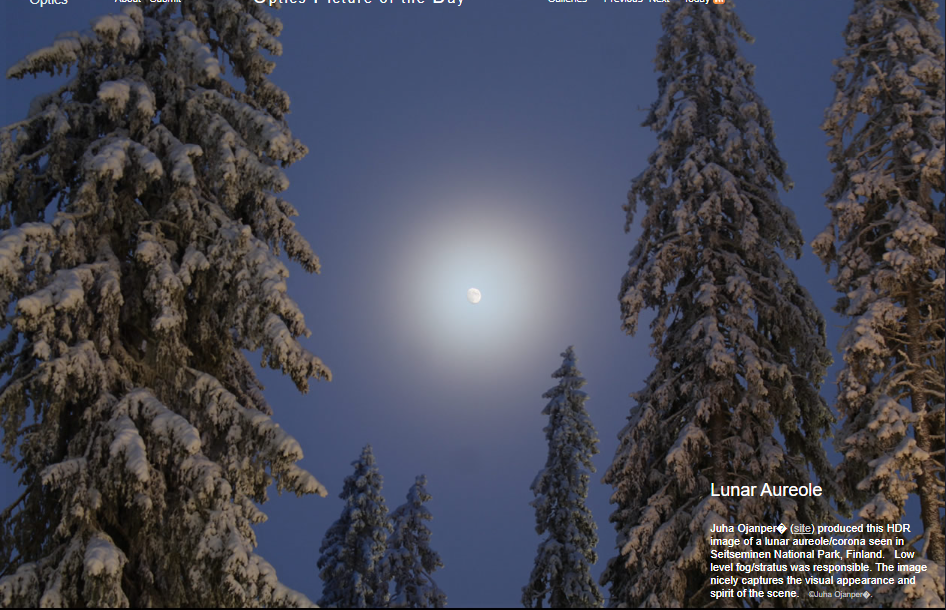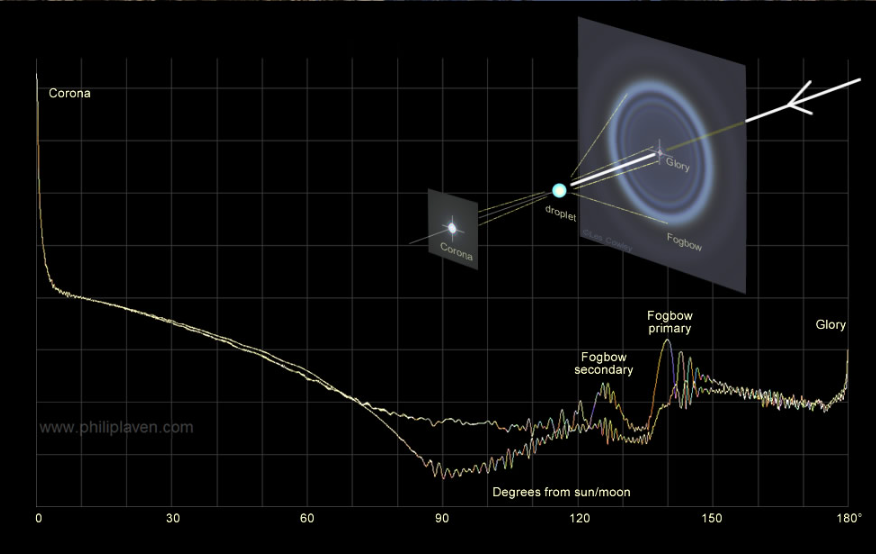OPOD - Corona, Finland
OPOD - Corona, Finland: A Spectacular Atmospheric Optics Phenomenon
Have you ever witnessed the ethereal beauty of a corona and aureole in the sky? In this article, we delve into the captivating atmospheric optics phenomenon captured by Juha Ojanperä in Seitseminen National Park, Finland. This HDR image showcases a lunar aureole/corona, enveloping the moon in a mesmerizing display of scattered light. Let's explore the intricate patterns created by scattering and diffraction from fog and cloud droplets, revealing the true magic of the sky.
Unveiling the Intricacies of Scattering and Diffraction
The corona and aureole represent just a fraction of the intricate pattern formed by the interplay of scattering and diffraction by fog and cloud droplets. Philip Laven's MiePlot program provides us with a deeper understanding of this phenomenon. By simulating the light scattering by 100-micron diameter droplets from the sun or moon to the antisolar (lunar) point directly opposite, we can observe the full extent of scattered brightness.
- The vertical scale of the simulation is logarithmic, with each division representing a tenfold increase in brightness.
- The rays or waves forming the corona, barely deviated from their original path, appear as the most intense scattered light.
- In the opposite hemisphere, we can observe the primary, secondary, and supernumerary fogbow components.
- Directly opposite the light source lies the glory, another intriguing optical phenomenon.
Polarized Light: Unveiling Nature's Complexity
When exploring polarized light within this atmospheric optics spectacle, we encounter fascinating insights:
- The corona, like its counterpart, the rainbow, exhibits an unpolarized nature.
- On the other hand, the fogbow displays strong polarization, mirroring the characteristics of a rainbow.
- The glory, however, presents a more intricate pattern of polarization, adding an extra layer of complexity to the phenomenon.
A Closer Look at Lunar Aureole
The HDR image captured by Juha Ojanperä in Seitseminen National Park, Finland, beautifully showcases the lunar aureole. This captivating phenomenon occurs when low-level fog or stratus interacts with the moonlight, creating a halo-like effect around the moon. The image not only captures the visual appearance of the lunar aureole but also embodies the spirit and essence of the scene, transporting viewers to this enchanting natural spectacle.
The Wonders of Scattering and Diffraction
Scattering and diffraction are fundamental processes that shape the captivating atmospheric optics phenomena we observe. In this case, fog and cloud droplets play a crucial role in creating the corona and aureole. These phenomena occur when light encounters tiny water droplets suspended in the atmosphere. As light interacts with these droplets, it scatters in various directions, giving rise to the intricate patterns we witness in the sky.
The Enigmatic Corona
The corona is a fascinating optical phenomenon that occurs when light waves interact with water droplets of similar size. In the case of the lunar aureole captured in Finland, 100-micron diameter droplets contribute to the formation of this captivating corona. The rays or waves forming the corona deviate minimally from their original path, resulting in an intense display of scattered light. This phenomenon adds an ethereal touch to the night sky, captivating observers with its mystique.
The Mesmerizing Fogbow
While exploring the intricate atmospheric optics spectacle in Finland, we encounter another enchanting phenomenon: the fogbow. Similar to its more colorful counterpart, the rainbow, the fogbow is formed when light waves interact with fog droplets. However, unlike the vibrant hues of a rainbow, the fogbow exhibits a delicate and subtle color palette. This optical phenomenon appears in the opposite hemisphere to the light source, captivating viewers with its ethereal beauty.
The Intricate Glory
Directly opposite the light source lies the glory, an intricate and captivating atmospheric optics phenomenon. This optical effect occurs when light waves interact with small water droplets or even airborne particles, such as dust or pollution. The glory manifests as a series of concentric rings of light, often exhibiting vibrant colors. Unlike other phenomena in the sky, the glory presents a complex pattern of polarization, adding an extra layer of fascination to its already mesmerizing nature.
A Captivating Natural Display
The lunar aureole captured in Seitseminen National Park, Finland, serves as a reminder of the awe-inspiring beauty of atmospheric optics phenomena. These natural displays, created by the interplay of scattering and diffraction, never fail to captivate our senses. Whether it's the ethereal corona, delicate fogbow, or intricate glory, each phenomenon offers a unique glimpse into the wonders of our atmosphere. Let us continue to marvel at these natural spectacles and seek to unravel the secrets they hold.

Lunar Aureole
Juha Ojanper� (site) produced this HDR image of a lunar aureole/corona seen in Seitseminen National Park, Finland. Low level fog/stratus was responsible. The image nicely captures the visual appearance and spirit of the scene. ©Juha Ojanper�.

A corona and aureole is only a part of the complex pattern that scattering and diffraction by fog and cloud droplets weave around the sky.
At left, Philip Laven's MiePlot program computes the light scattering by 100 micron dia. droplets all the way from the sun or moon to the antisolar (lunar) point directly opposite.
Light is scattered in all directions. The vertical scale is logarithmic and each division 10X. The range of scattered brightness is enormous. The barely deviated rays (waves) of the corona are the most intense.
The fogbow's primary, secondary and supernumeraries show up in the opposite hemisphere. Directly opposite the light source is the glory.
The two components of polarised light are shown. We see that the corona is unpolarised. The fogbow (like the rainbow) is strongly polarised. The glory is polarised in a complicated manner.
Note: this article has been automatically converted from the old site and may not appear as intended. You can find the original article here.
Reference Atmospheric Optics
If you use any of the definitions, information, or data presented on Atmospheric Optics, please copy the link or reference below to properly credit us as the reference source. Thank you!
-
<a href="https://atoptics.co.uk/blog/opod-corona-finland/">OPOD - Corona, Finland</a>
-
"OPOD - Corona, Finland". Atmospheric Optics. Accessed on December 22, 2024. https://atoptics.co.uk/blog/opod-corona-finland/.
-
"OPOD - Corona, Finland". Atmospheric Optics, https://atoptics.co.uk/blog/opod-corona-finland/. Accessed 22 December, 2024
-
OPOD - Corona, Finland. Atmospheric Optics. Retrieved from https://atoptics.co.uk/blog/opod-corona-finland/.